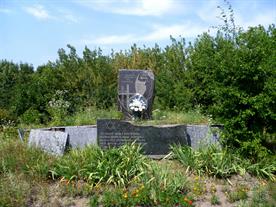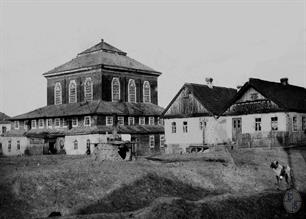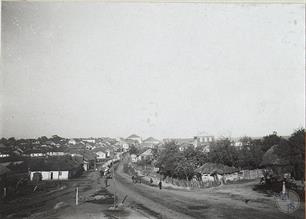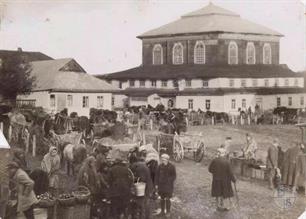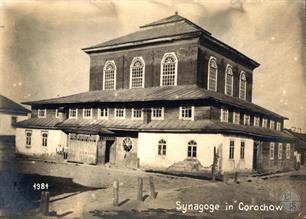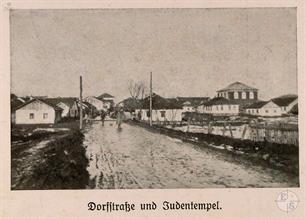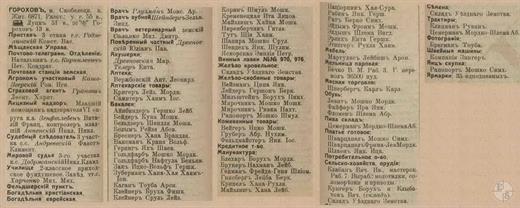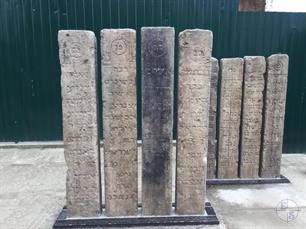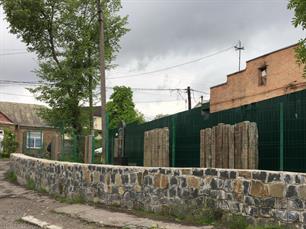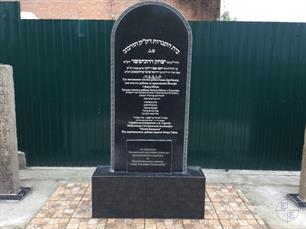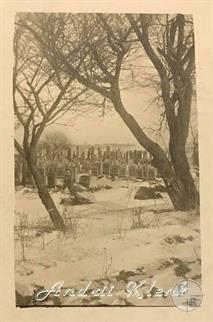Horokhiv
Horokhiv district, Volyn region
Sources:
- Jewish encyclopedia of Brockhaus & Efron;
- Russian Jewish encyclopedia;
- Yad Vashem. Horochow;
- Virtual Shtetl. Horokhiv;
- Encyclopedia of Jewish Life Before and During the Holocaust, vol. 1, eds. Sh. Spector, G. Wigoder, New York 2001, pp. 527–528.
- The All South-Western Territory: reference and address book of the Kyiv, Podolsk and Volyn provinces. Printing house L.M. Fish and P.E. Wolfson, 1913.
Photo:
- European Jewish Cemeteries Initiative. Horokhiv Jewish Cemetery
- Austrian National Library
- Alter Kacizne (1920s). Yivo Digital Archive. Horochow
- The Center for Jewish Art. Horokhiv (Gorokhov, Horochуw)
- Viacheslav Galievskyi, Wikipedia. Memorial sign to the Jews, executed by Nazis in Horokhiv
- Archive of Andriy Klenk
- Jewish encyclopedia of Brockhaus & Efron;
- Russian Jewish encyclopedia;
- Yad Vashem. Horochow;
- Virtual Shtetl. Horokhiv;
- Encyclopedia of Jewish Life Before and During the Holocaust, vol. 1, eds. Sh. Spector, G. Wigoder, New York 2001, pp. 527–528.
- The All South-Western Territory: reference and address book of the Kyiv, Podolsk and Volyn provinces. Printing house L.M. Fish and P.E. Wolfson, 1913.
Photo:
- European Jewish Cemeteries Initiative. Horokhiv Jewish Cemetery
- Austrian National Library
- Alter Kacizne (1920s). Yivo Digital Archive. Horochow
- The Center for Jewish Art. Horokhiv (Gorokhov, Horochуw)
- Viacheslav Galievskyi, Wikipedia. Memorial sign to the Jews, executed by Nazis in Horokhiv
- Archive of Andriy Klenk
Horokhiv, town (since 1939), district center. Known since 1240. From 1795 - as part of the Russian Empire. In the 19th - beginning of the 20th century - the township of Vladimir-Volynski district of the Volyn province.
In 1765, 752 Jews lived in Horokhiv,
in 1778 - 442,
in 1790 - 597,
in 1847 - 1964,
in 1897 - 2571 (54.7%),
in 1921 - 2377 (53.7%),
in 1931 - 2806 (46%),
In 1937 - 3120 Jews (40%).
The earliest record referring to Jews in Horochуw (currently Horokhiv) dates back to 1536. In second half of the 16th century, a Jewish street existed in this noble-owned town. The community started to develop during the Russian Partition.
Jews made a living from trade in grain, cattle, and poultry, as well as from crafts. In religious terms, the community was dominated by Hasidic Jews hailing from competing courts in Ołyka (Olyka), Turzysk (Turiisk) and Karlin-Stolin.
In the 19th century, the rabbis were Refoil Mayzelish, Yakov Finkelstein, from 1891 - Efraim Averbakh (1856-1925).
In 1863 there were 3 synagogues in the town, in 1889 the Jewish almshouse acted.
In 1909, a school was opened with teaching in Hebrew.
In 1765, 752 Jews lived in Horokhiv,
in 1778 - 442,
in 1790 - 597,
in 1847 - 1964,
in 1897 - 2571 (54.7%),
in 1921 - 2377 (53.7%),
in 1931 - 2806 (46%),
In 1937 - 3120 Jews (40%).
The earliest record referring to Jews in Horochуw (currently Horokhiv) dates back to 1536. In second half of the 16th century, a Jewish street existed in this noble-owned town. The community started to develop during the Russian Partition.
Jews made a living from trade in grain, cattle, and poultry, as well as from crafts. In religious terms, the community was dominated by Hasidic Jews hailing from competing courts in Ołyka (Olyka), Turzysk (Turiisk) and Karlin-Stolin.
In the 19th century, the rabbis were Refoil Mayzelish, Yakov Finkelstein, from 1891 - Efraim Averbakh (1856-1925).
In 1863 there were 3 synagogues in the town, in 1889 the Jewish almshouse acted.
In 1909, a school was opened with teaching in Hebrew.
World War I brought extensive destruction to the town, further exacerbated by a brief period of occupation of the town by Petliura's troops. The situation of the community improved under the Second Polish Republic, although it never regained its pre-war prosperity.
The Zionist movement, present in Horokhiv since the beginning of the 20th century, was becoming more and more popular. The local Zionists ran a Hebrew school and a farm preparing settlers for departure to Palestine. Branches of Agudath Israel, the Bund, and more than one Zionist political party were all active in the town.
Jews were dominant in the economical life of the town - they owned several flour mills and were active in the local clothing industry, in carpentry, and in construction.
In 1913? Jews owned more than 50 shops (including 21 of 22 grocery, all 13 manufactory), beer warehouse, photographer's parlor, both taverns.
Jews were a town doctor and dentist
After 1925, the rabbis of Horokhiv were two sons -in -law of Efraim Averbakh - Shmuel Raisher (Olyka Hasid) and Yeshua Rabinovich (both died during Shoah).
After September 17, 1939, with the arrival of the Red Army in the town following the Ribbentrop-Molotov Pact, Horokhiv became part of Soviet Ukraine. The Soviet authorities closed most private businesses and Jewish communal organizations. On the eve of the Soviet - German war the Jewish population of the town was about 3,000 or half of its total population.
The Zionist movement, present in Horokhiv since the beginning of the 20th century, was becoming more and more popular. The local Zionists ran a Hebrew school and a farm preparing settlers for departure to Palestine. Branches of Agudath Israel, the Bund, and more than one Zionist political party were all active in the town.
Jews were dominant in the economical life of the town - they owned several flour mills and were active in the local clothing industry, in carpentry, and in construction.
In 1913? Jews owned more than 50 shops (including 21 of 22 grocery, all 13 manufactory), beer warehouse, photographer's parlor, both taverns.
Jews were a town doctor and dentist
After 1925, the rabbis of Horokhiv were two sons -in -law of Efraim Averbakh - Shmuel Raisher (Olyka Hasid) and Yeshua Rabinovich (both died during Shoah).
After September 17, 1939, with the arrival of the Red Army in the town following the Ribbentrop-Molotov Pact, Horokhiv became part of Soviet Ukraine. The Soviet authorities closed most private businesses and Jewish communal organizations. On the eve of the Soviet - German war the Jewish population of the town was about 3,000 or half of its total population.
The Germans entered the town on June 26, 1941. Most its Jewish population did not succeed in fleeing. Shortly afterward, the Germans appointed a Judenrat (Jewish council). The Germans also forced the Jews to pay a large ransom, ordered Jewish inhabitants to wear a Star of David armband (replaced later on by a yellow patch), and conscripted them for forced labor.
According to some testismonies, before the end of June 1941 a Security Police unit sent by Sonderkommando 4a to Horokhiv, assisted by Ukrainian auxiliary police, shot to death several people, including Jews, for being "Communist functionaries."
In early July the Germans gathered the Jews in the marketplace and made them watch the burning of the synagogue, and its Torah scrolls and prayerbooks.
On a date reported to be August 12, 1941, a unit of Einsatzkommado 4a, aided by Ukrainian auxiliary police, shot to death 300 Jews in the town park.
In October or early November 1941, a ghetto surrounded by a high wooden fence topped with barbed wire, was set up in the town and an additional 2,000 Jews from nearby localities were incarcerated in the ghetto. The latter was severely overcrowded and starvation prevailed.
The ghetto was divided into two sections, one for skilled workers considered needed by the Germans, and their families, and the other section - for "unnecessary workers." Those who worked outside the ghetto were mainly tanners, who prepared leather for military use, or laborers used for road construction.
Women performed jobs such as cleaning. Some Jews set up workshops where other Jews were engaged in knitting, making brushes, and other craft activities.
The workshops were located outside the ghetto. According to one testimony, several women succeeded in organizing for several months a clandestine school in the ghetto. According to the same testimony, since the ghetto population had decreased so drastically, in the spring of 1942 the ghetto Jews who remained were moved to a smaller area.
The ghetto was liquidated at the beginning of September 1942, when its inmates were shot to death, by a German unit, near the village of Czujew. Horochуw was liberated by the Red Army on April 3, 1944.
According to some testismonies, before the end of June 1941 a Security Police unit sent by Sonderkommando 4a to Horokhiv, assisted by Ukrainian auxiliary police, shot to death several people, including Jews, for being "Communist functionaries."
In early July the Germans gathered the Jews in the marketplace and made them watch the burning of the synagogue, and its Torah scrolls and prayerbooks.
On a date reported to be August 12, 1941, a unit of Einsatzkommado 4a, aided by Ukrainian auxiliary police, shot to death 300 Jews in the town park.
In October or early November 1941, a ghetto surrounded by a high wooden fence topped with barbed wire, was set up in the town and an additional 2,000 Jews from nearby localities were incarcerated in the ghetto. The latter was severely overcrowded and starvation prevailed.
The ghetto was divided into two sections, one for skilled workers considered needed by the Germans, and their families, and the other section - for "unnecessary workers." Those who worked outside the ghetto were mainly tanners, who prepared leather for military use, or laborers used for road construction.
Women performed jobs such as cleaning. Some Jews set up workshops where other Jews were engaged in knitting, making brushes, and other craft activities.
The workshops were located outside the ghetto. According to one testimony, several women succeeded in organizing for several months a clandestine school in the ghetto. According to the same testimony, since the ghetto population had decreased so drastically, in the spring of 1942 the ghetto Jews who remained were moved to a smaller area.
The ghetto was liquidated at the beginning of September 1942, when its inmates were shot to death, by a German unit, near the village of Czujew. Horochуw was liberated by the Red Army on April 3, 1944.
The Jewish cemetery was demolished and gravestones were used for road construction. Horokhiv’s central market was built on the cemetery site. Gravestones were located near the cemetery until 1965, and removed by local authorities afterwards. Some gravestones were broken in half and used as road paving.
In April 2018, around 40 gravestones that had been used as such were discovered and placed close to the former cemetery area. The local Jewish community constructed a memorial to the destroyed cemetery from these gravestone fragments with the help of local authorities. The memorial also includes a tziyun to Itzchak Drubitscher, father of famous Hasidic tsadik Ikhel-Mikhel from Zolochiv.
In April 2018, around 40 gravestones that had been used as such were discovered and placed close to the former cemetery area. The local Jewish community constructed a memorial to the destroyed cemetery from these gravestone fragments with the help of local authorities. The memorial also includes a tziyun to Itzchak Drubitscher, father of famous Hasidic tsadik Ikhel-Mikhel from Zolochiv.

- Home
- Shtetls
- Vinnytsia region
- Volyn region
- Dnipro region
- Donetsk region
- Zhytomyr region
- Zakarpattia region
- Zaporizhzhia region
- Ivano-Frankivsk region
- Kyiv region
- Kropyvnytskyi region
- Luhansk region
- Lviv region
- Mykolayiv region
- Odessa region
- Poltava region
- Rivne region
- Sumy region
- Ternopil region
- Kharkiv region
- Kherson region
- Khmelnytskyi region
- Chernihiv region
- Chernivtsi region
- Cherkasy region
- Crimea
- Synagogues
- Cemeteries
- Objects & guides
- Old photos
- History
- Contact
Jewish towns of Ukraine
My shtetl
My shtetl
Donate
Jewish towns of Ukraine
